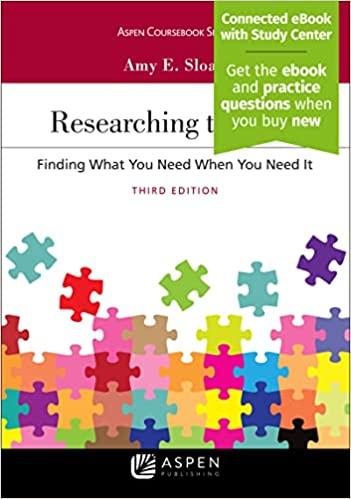Question
1.Jackson was the owner of thirty highly bred dairy cows. He was a successful rancher, but his health was not good. His physician advised him
1.Jackson was the owner of thirty highly bred dairy cows. He was a successful rancher, but his health was not good. His physician advised him to spend some time in a warm climate, and he decided to spend the winter months in Florida. He entered into an agreement with a neighboring rancher, Thompson, to keep his cows on Thompson's ranch during the winter months for which Jackson would pay him $3,000. The cows would be picked up by Jackson upon his return. Thompson, without Jackson's approval, sold ten of Jackson's cows and replaced them with ten cows before the pick-up date. Is Thompson liable for conversion of the original ten cows? Please explain.
2. Dorothy entered into an agreement with Ken to repair her grandfather clock for $200. As soon as Ken gained possession of the clock, he sold it to the General Repair Co for $200. The General Repair Co was in the business of repairing and selling clocks.
Four months later, Dorothy was in the General Repair Co and saw a clock on sales the same as the one she had turned over to Ken. The General Repair Co had replaced quite a few parts and had done extensive work on the exterior cabinet.
The General Repair Co said it purchased the clock in the normal course of business from Ken, who claimed the clock belonged to his late father. The fair market value of the clock in the original condition was $300, and the value of repairs made was $2,000.
Dorothy sued the General Repair Co for return of the clock. The General Repair Co defended that it had proper title to the clock and, in the alternative, that Dorothy must pay the value of the repairs and the amount the company paid for the clock if she is entitled to regain possession. Who will prevail? Why?
3. Jones had 50 crates of oranges equally divided between grades A, B, and C, grade A being the highest quality and C being the lowest. Smith had 1,000 crates of oranges, about 90 percent of which were grade A, but some of which were grades B and C, the exact percentage of each being unknown. Smith willfully mixed Jones's crates with his own so that it was impossible to identify any particular crate. Jones seized the whole lot. Smith demanded 900 crates of grade A and 50 crates each of grades B and C. Jones refused to give them up unless Smith could identify particular crates. This Smith could not do. Smith brought an action against Jones to recover what he demanded or its value. Judgment for whom, and why?
Step by Step Solution
There are 3 Steps involved in it
Step: 1

Get Instant Access to Expert-Tailored Solutions
See step-by-step solutions with expert insights and AI powered tools for academic success
Step: 2

Step: 3

Ace Your Homework with AI
Get the answers you need in no time with our AI-driven, step-by-step assistance
Get Started


